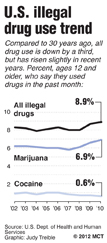The market for drugs
September 27, 2013
The notion of a ‘controlled substance’ is a myth.
Coca, the plant that naturally produces cocaine, has been consumed by humans for thousands of years, and humans have ingested marijuana for over 10,000 years, according to Robert O. Keel at the University of Missouri St. Louis. Nearly every civilization that has existed on Earth has utilized drugs in some socially accepted way.
The federal government has placed particular substances under the umbrella of the Controlled Substances Act to rid America of substances with its so-called ‘war on drugs.’
An unintended consequence of this policy is that the government essentially gives up all control and regulation potential that it once held.
Today drugs remain available for nearly anyone who wants them, even with the war on drugs – which was declared back in the Nixon administration – still raging.
The government, comprising of federal, state and local segments, spends approximately $50 billion a year on the pitiful attempt to rid the United States of ‘dangerous’ drugs, according to Tony Newman, director of media relations at the Drug Policy Alliance. And according to Matt Sledge at The Huffington Post, over four decades of the useless drug war has cost the country $1 trillion dollars.
This indicates that, as a country, we spend more money on keeping drug offenders locked up in the prison system than on education. Meanwhile, cities such as Detroit suffer from crippling violence that stems from drug prohibition rather than drug use itself.
By making a substance illegal, the market that once existed for the product is driven underground. There is still a demand for that drug, and if that demand cannot be met by a safe, legal and regulated market, then an underground and illicit market will fill the void.
These underground markets are sketchier than and not as safe as they could be if they were a result of regulated industries. The underground drug trade is worth up to $100 billion a year federally, according to Keel. This is money that is going untaxed and is essentially missed income for the government.
If these substances were legalized and regulated, the tax revenue from the sales would be astounding and people would know exactly what product they were getting. Regulations would be in place that would enforce pharmaceutical grade purity for these drugs. This is better than homegrown garbage that was concocted in some junkie’s basement.
A perfect example of how outlawing a drug doesn’t work was the prohibition of alcohol that began on Jan. 19, 1920.
Just prior to the legislation being passed, industries including restaurants and theaters all predicted sales and attendance would increase due to a new lack of ‘entertainment’ from alcohol, according to Michael Lerner at PBS.
Unfortunately, as with the majority of idiotic government regulations, prohibition had drastic unintended consequences, which were opposite to the primary goals of the legislation.
Sales and revenues of entertainment and restaurant industries declined across the board, contrary to the hopes of these businesses. Restaurants began to fail because many owed much of their revenue to alcohol sales. In addition, thousands of jobs were eliminated due to the closing of breweries and distilleries and indirect job losses included waiters, truckers and coopers.
Massive amounts of tax revenue were also lost during prohibition. For example, New York State derived nearly 75 percent of its revenue from liquor sales, which was consequently lost during prohibition, according to Lerner. Overall, the federal government lost about $11 billion in tax revenue while spending $300 million to enforce the law.
With the legal industry outlawed, bootleggers and illegal importers began distilling and selling illegal alcohol. Since the alcohol was not regulated or inspected in any way, around 1,000 people died each year from contaminated batches, according to Lerner.
Prohibition led millions of Americans to pursue illegal practices, and organized crime became even more powerful. A gangster known as Al Capone became one of the most notorious alcohol smugglers of this time and gained incredible power, enabling him to expand into other crime industries such as prostitution and racketeering.
Due to the massive increase in ‘crime,’ jails became overcrowded and the courts could barely keep up with the influx of new offenders. Some alcohol related cases took over a year to be brought to trial, according to Lerner.
Prohibition of alcohol is the perfect example of how prohibition of any vice simply does not work. Through the regulation and taxing of substances, society can greatly benefit.









